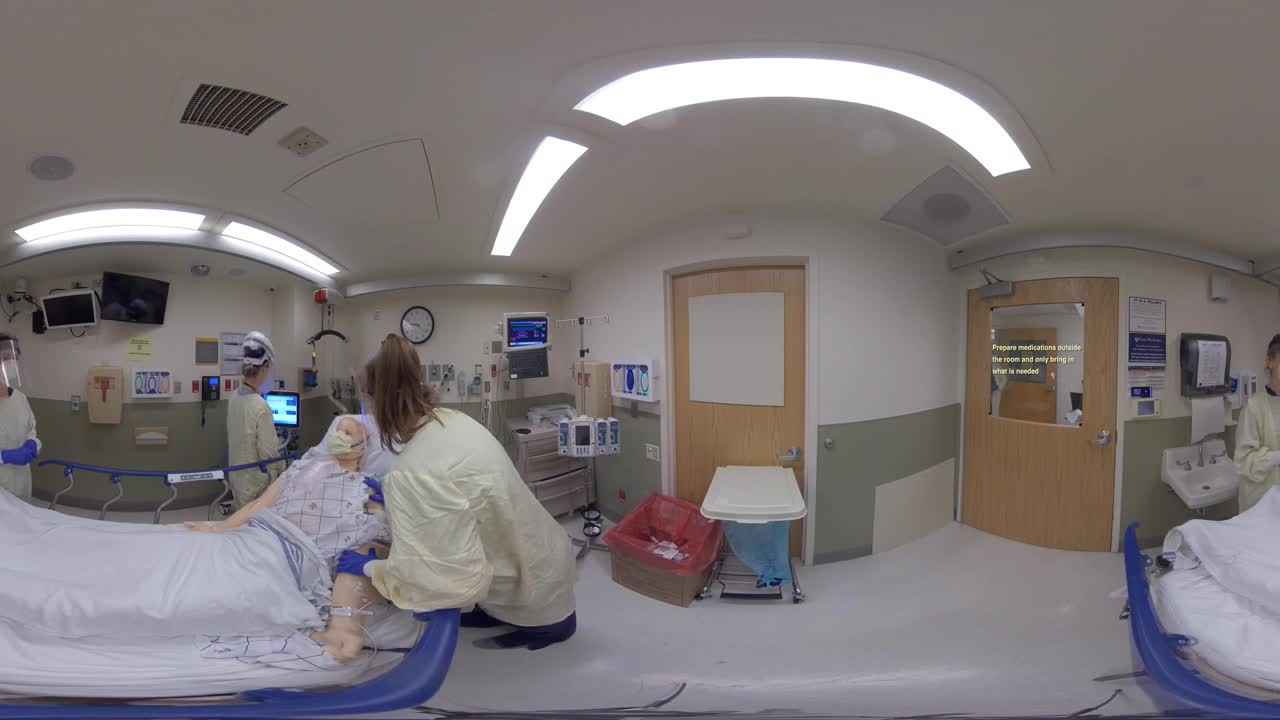Premium Only Content

360° Video: Resuscitation of a COVID-19 Patient w/ Respiratory Failure Best Practices Demonstration
This immersive 360 degree video takes you inside a hospital emergency department and shows you - using "pop-up text" - the best practices learned by medical staff in New York City and Philadelphia for treating critically ill COVID-19 patients with respiratory failure.
View on an ordinary computer screen, smartphone, or with a virtual reality headset such as the inexpensive Google Cardboard - https://arvr.google.com/cardboard/
Please help us improve future videos by taking our short survey: https://weillcornell.az1.qualtrics.co...
How to Watch on a VIRTUAL REALITY HEADSET (including smartphones)
Use your smartphone to view in 360 with an inexpensive VR headset such as the Google Cardboard: https://arvr.google.com/cardboard
• First download the YouTube App on your phone.
• Android Phones: https://play.google.com/store/apps/de...
• iPhones: https://apps.apple.com/us/app/youtube...
• Load this video into the YouTube App.
• Press the PLAY button, and then press the "VR goggle icon" in the bottom right hand corner.
• Close your phone into the headset.
• Looking through the eyepieces, you can turn your head LEFT, RIGHT, UP, and DOWN to watch the immersive video.
• If you have a dedicated VR headset (e.g. Oculus, HTC Vive, etc), there are a number of apps to play 360 YouTube content:
• DeoVR for the Rift.
• Vive and YouTube VR for the Oculus Go.
How to watch on a FLAT SCREEN (computer)
• Load the YouTube video.
• Choose the highest resolution your computer can comfortably play (e.g. 1040sHD) from the gear icon on the bottom right corner.
How to Watch on a SMARTPHONE or TABLET without a VR HEADSET
• Smartphones and tablets have internal motion detectors that allow you to experience some of the immersiveness of the video without a headset.
• Load the video in the YouTube app, press PLAY, hold the screen in front of you and you can turn the phone to look UP, DOWN, LEFT, and RIGHT.
Video © 2020 Weill Cornell Medicine, NewYork Presbyterian Hospital, and The Trustees of the University of Pennsylvania.
DISCLAIMER: The information contained in this video content is for informational and educational purposes only. The video content is not intended to be a substitute for professional medical advice, diagnosis, or treatment. For more details, see the disclaimer in the video.
-
 8:02
8:02
Adam Does Movies
22 hours ago $1.28 earnedM3GAN 2.0 - Movie Review
15.6K4 -
 11:33
11:33
Clownfish TV
15 hours agoHollywood Writers FAFO: Their Jobs are GONE!
27.6K17 -
 1:57:25
1:57:25
BEK TV
3 days agoTrent Loos in the Morning 6/30/2025
11.6K1 -
 10:09
10:09
Forrest Galante
1 day agoWildlife Expert Reacts to Crazy Animal Zoo Attack TikToks
110K21 -
 46:55
46:55
The Connect: With Johnny Mitchell
1 day ago $20.19 earnedInside A Mexican Sicario Training Camp: How The Jalisco New Generation Cartel Trains It's KILLERS
128K29 -
 LIVE
LIVE
PudgeTV
3 hours ago🟠 Gaming on Rumble | Witcher 3: The Wild Hunt | Should I Bring Back the Death Counter?
181 watching -
 9:03
9:03
MattMorseTV
1 day ago $9.50 earnedTrump just SHATTERED the RECORD.
71K63 -
 1:28:30
1:28:30
The Pascal Show
13 hours ago $9.78 earnedBREAKING! AMBUSHED! Multiple Idaho Firefighter s Ambushed By GUNMAN! Suspects AT LARGE?!
51K17 -
![This game no longer exists | [6-30-25] | THE CYCLE: FRONTIER](https://1a-1791.com/video/fww1/f0/s8/1/Z/g/4/X/Zg4Xy.0kob-small-This-game-no-longer-exists-.jpg)
HEXIK
7 hours agoThis game no longer exists | [6-30-25] | THE CYCLE: FRONTIER
15.8K -
 LIVE
LIVE
ADH Gaming
12 hours agoTasking, Lootin, shootin/ hUNT sHOWDOWN
78 watching